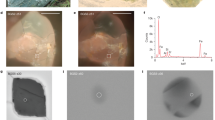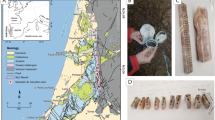Abstract
Past values for the geomagnetic intensity may be obtained by laboratory analysis of the thermoremanent magnetization carried by clay baked in ancient times. From global averages1–3 of such determinations it is commonly accepted that the intensity in any given region went through a broad maximum about 2,000 years ago, reaching a level ∼50% higher than at present. Here we present results obtained from a wide range of Chinese pottery, spanning the interval from 4000 BC to the present, indicating that the field behaviour was more complex. The intensity was high between 1500 and 1000 BC and again in the first half of the first millennium AD. Comparison with results reported4,5 for Western Asia, Egypt and Crete suggests that these high values are due to non-dipole disturbances in the geomagnetic field, consistent with long-term records6–8 of the cosmogenic radioisotopes 14C and 10Be.
This is a preview of subscription content, access via your institution
Access options
Subscribe to this journal
Receive 51 print issues and online access
$199.00 per year
only $3.90 per issue
Buy this article
- Purchase on Springer Link
- Instant access to full article PDF
Prices may be subject to local taxes which are calculated during checkout
Similar content being viewed by others
References
1. Smith, P. J. Geophys. J. R. astr. Soc. 12, 213–362 (1967). 2. Cox, A. / geophys. Res. 73, 3257–60 (1968). 3. McElhinny, M. W. & Senanayake, W. E. /. Geomagn. Geoelectr. 34, 39–51 (1982). 4. Aitken, M. J., Allsop, A. L., Bussell, G. D. & Winter, M. B. Nature 310, 306–308 (1984). 5. Aitken, M. J., Alcock, P. A., Bussell, G. D. & Shaw, C. J. in Geomagnetism of Baked Clays and Recent Sediments (eds Creer, K. M., Tucholka, P. & Barton C. E.) 122–127 (Elsevier, Amsterdam 1983). 6. Stuiver, M. & Pearson, G. W. Radiocarbon 28, 805–838 (1986). 7. Pearson, G. W. & Stuiver, M. Radiocarbon 28, 839–862 (1986). 8. Beer, J. et al. Nucl. Instrum. Meth. B5, 380–384 (1984). 9. Thellier, E. & Thellier, O. Ann. Geophys. 15, 285–367 (1959). 10. Aitken, M. J., Alcock, P. A., Bussell, G. D. & Shaw, C. J. Archaeometry 23, 53–64 (1981). 11. Aitken, M. J., Allsop, A. L., Bussell, G .D. & Winter, M. J. Geomagn. Geoelectr. 38,1355–1363 (1986). 12. Barton, C. E., Merrill, R. T. & Barbetti, M. Phys. Earth planet. Inter. 20, 96–110 (1979). 13. Bullard, E. C., Freedman, C., Gellman, H. & Nixon, J. Phil. Trans. R. Soc. 243,67–92 (1950).
Author information
Authors and Affiliations
Rights and permissions
About this article
Cite this article
Quing-Yun, W., Wei-Xi, Z., Dong-Jie, L. et al. Geomagnetic intensity as evaluated from ancient Chinese pottery. Nature 328, 330–333 (1987). https://doi.org/10.1038/328330a0
Received:
Accepted:
Issue Date:
DOI: https://doi.org/10.1038/328330a0
This article is cited by
-
Greek archaeomagnetic intensities: Some aspects of reliability and geophysical implications
Earth, Moon and Planets (1989)
Comments
By submitting a comment you agree to abide by our Terms and Community Guidelines. If you find something abusive or that does not comply with our terms or guidelines please flag it as inappropriate.



